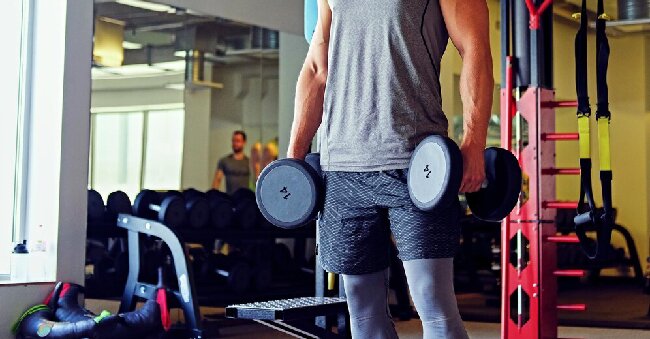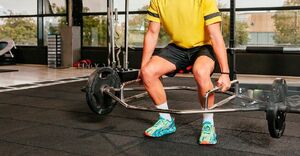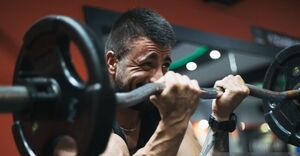
Safe Dumbbell Use Guide: Key Techniques to Prevent Exercise Injuries
Dumbbells are a common sight in gyms and home workout spaces, but do you really know the ins and outs of using them safely and effectively?
In this comprehensive guide, we’ll take a deep dive into the world of dumbbells, covering everything from their different types to the benefits of using them in your workout routine.
We’ll also explore some common mistakes to avoid and provide key techniques to prevent injuries while exercising with dumbbells.
Whether you’re a seasoned gym-goer or just starting out, this article has something for everyone looking to maximize their workout potential.
So, grab your dumbbells and get ready to learn how to use them like a pro!
What Are Dumbbells?
Dumbbells are versatile exercise equipment commonly used in weightlifting, strength training, and fitness workouts.
Dumbbells are available in a variety of sizes and weights, making them suitable for people of all fitness levels. They offer a wide range of exercises that target different muscle groups, providing a comprehensive full-body workout.
From bicep curls to shoulder presses and squats, dumbbells can be used for a variety of exercises that engage stabilizing muscles, improve coordination, and promote functional strength. Incorporating dumbbell workouts into a training regimen can also lead to increased muscle endurance, improved bone density, and better weight management, making them a valuable asset for anyone looking to improve overall fitness and strength.
Why Are Dumbbells Used In Exercises?
Dumbbells are used in exercises to build muscle strength, enhance fitness levels, and promote overall physical well-being.
Dumbbells offer a versatile approach to strength training, allowing for a wide range of movements and targeting specific muscle groups. Incorporating them into workout routines can lead to significant gains in muscle mass and definition.
The use of dumbbells engages stabilizing muscles, fostering improved balance and coordination, which are foundational for overall physical fitness. Additionally, their compact size and varied weight options make them a convenient choice for individuals looking to personalize their exercise programs and progress at their own pace.
What Are The Different Types Of Dumbbells?
Dumbbells come in various types, including fixed-weight, adjustable, and selectorized options, each offering unique features and benefits for weightlifting and fitness.
Fixed-weight dumbbells are individual pieces with a set weight, making them ideal for quick movements and targeting specific muscle groups.
Adjustable dumbbells allow you to change the weight plates, providing versatility for different exercises and fitness levels.
Selectorized dumbbells have a mechanism for adjusting the weight with a simple turn of a dial, suitable for efficient and smooth transitions between exercises.
Each type of dumbbell offers different advantages, catering to various preferences and workout needs.
Fixed-weight Dumbbells
Fixed-weight dumbbells are a standard choice for weightlifting and exercise routines in gyms and fitness centers, offering consistent resistance for various strength-building exercises.
The fixed weight design of these dumbbells eliminates the need for manual adjustments, making them convenient and time-efficient for quick transitions between exercises.
Available in a range of weight options, these dumbbells cater to beginners and advanced weightlifters alike. Their durable construction allows them to withstand heavy use in gym environments, ensuring longevity and reliability for users.
Additionally, their compact nature allows for easy storage, making them a versatile option for home gyms as well.
Adjustable Dumbbells
Adjustable dumbbells provide versatility and convenience for workout routines, allowing users to modify the weight levels and adapt to various fitness exercises.
Adjustable dumbbells are a great option for those with limited space, as they can replace multiple sets of traditional dumbbells. This makes them perfect for home gyms. The convenience of being able to quickly adjust the resistance level caters to different strength levels and allows for seamless transitions between exercises, resulting in a more efficient workout.
Using adjustable dumbbells with proper form and technique can help build strength and muscle tone while reducing the risk of injury associated with handling multiple sets of fixed-weight dumbbells.
Selectorized Dumbbells
Selectorized dumbbells offer quick weight adjustments and targeted muscle isolation, making them a popular choice for strength training and muscle development.
This type of dumbbell allows users to easily change the weight by simply turning a dial or sliding a pin, eliminating the need for multiple pairs of dumbbells. This convenience makes them ideal for circuit training and high-intensity interval workouts.
The ability to target specific muscle groups with precision promotes balanced muscle development and reduces the risk of imbalances or overuse injuries. Incorporating selectorized dumbbells into a weightlifting program can enhance muscle targeting, strength gains, and overall workout efficiency.
What Are The Benefits Of Using Dumbbells?
Using dumbbells yields multiple benefits, including improvements in muscle strength, enhanced balance and coordination, and increased joint stability for overall fitness and well-being.
These versatile weights can be utilized to target specific muscle groups, promoting a comprehensive and balanced muscle development.
Incorporating dumbbells into a workout routine can aid in enhancing overall balance and coordination, as the focused movements engage stabilizing muscles.
The controlled movements required when using dumbbells contribute to strengthening joints, which can minimize the risk of injury and improve overall joint stability, ensuring sound and effective fitness progress.
Improves Muscle Strength
Dumbbell exercises are effective in improving muscle strength and promoting injury prevention through targeted strength training and controlled movements.
Dumbbells offer a versatile approach to building muscle. They allow for unilateral movements that can address muscle imbalances and weaknesses.
Using dumbbells also engages stabilizing muscles, enhancing overall muscle development and functional strength. The controlled nature of dumbbell exercises reduces the risk of overuse injuries and improves joint stability, making them an essential tool for those looking to enhance their strength safely and effectively.
Enhances Balance and Coordination
Incorporating dumbbells into exercises helps enhance balance and coordination, contributing to overall wellness and fitness through controlled movements and muscle engagement.
Dumbbells are versatile tools that add a challenge to traditional workouts by engaging multiple muscle groups at once. This improves stability and coordination. For example, lunges, bicep curls, and shoulder presses require individuals to stabilize their bodies, enhancing balance. This also improves proprioception, or body awareness, resulting in better coordination and agility. By regularly incorporating dumbbell exercises, individuals can achieve physical well-being and better control over their movements.
Increases Joint Stability
Dumbbell exercises aid in increasing joint stability and promoting muscle health, contributing to injury-free workouts and sustained physical well-being.
Dumbbells play a crucial role in enhancing muscle strength and improving joint flexibility. This effectively reduces the risk of injuries during physical activities.
Incorporating dumbbells into your fitness routine helps maintain a balanced muscular development and enhances overall functional strength. This makes them a valuable component of injury prevention and management.
The versatility of dumbbells allows for a wide range of exercises targeting different muscle groups. This contributes to a well-rounded and effective fitness program.
Allows for Versatile Workouts
Dumbbells enable versatile workout routines that cater to diverse fitness goals, offering flexibility and adaptability in personalized exercise regimens.
Dumbbells are indispensable tools for targeting specific muscle groups, increasing strength, or improving endurance. They can be incorporated into high-intensity interval training or used for isolated exercises, making them versatile for a wide range of fitness objectives.
Their adaptability also allows for easy adjustment of resistance levels, making them suitable for both beginners and seasoned fitness enthusiasts. With proper guidance, individuals can create a tailored workout plan using dumbbells that aligns with their unique fitness aspirations.
What Are The Common Mistakes When Using Dumbbells?
Several common mistakes when using dumbbells include incorrect form, lifting excessive weight, inadequate warm-up, and neglecting the need for a spotter, leading to potential injury risks and reduced effectiveness of the workout.
Improper form while using dumbbells can cause muscle strain and compromise the overall effectiveness of the exercise. Lifting weights that are too heavy can lead to muscle imbalances and potential injuries.
Inadequate warm-up practices before using dumbbells can increase the risk of muscle pulls or strains. Neglecting to have a spotter when lifting heavy dumbbells can be dangerous, as it may lead to accidents or dropping the weights. It is essential to address these errors to ensure injury prevention and exercise safety.
Using Incorrect Form
Utilizing incorrect form during dumbbell exercises can lead to muscle strain, overexertion, and increased risk of exercise-related injuries, compromising the effectiveness of the workout and the well-being of the individual.
This is especially crucial when performing exercises targeting major muscle groups such as the chest, back, and arms. Improper form not only reduces the efficacy of the workout but also raises the likelihood of muscle imbalances and strain.
It’s vital to maintain proper posture and controlled movements to prevent unnecessary stress on the muscles, joints, and tendons. By prioritizing correct techniques and gradually increasing the intensity, individuals can minimize the risk of injury and promote long-term muscle health.
Lifting Too Much Weight
Lifting excessively heavy weights during dumbbell exercises can strain muscles, compromise joint health, and increase the risk of workout-related injuries. This can ultimately lead to potential setbacks in strength development and overall fitness.
It is crucial to listen to your body and gradually increase the weight to avoid overexertion. Muscle strain from lifting too much weight can lead to discomfort and hinder future workouts.
Compromised joint health due to excessive weight can increase the risk of long-term injuries. It’s important to maintain proper form and technique to minimize strain on the joints. By prioritizing caution and gradually increasing weight, individuals can mitigate the risk of potential setbacks and ensure a sustainable and safe workout routine.
Not Warming Up Properly
Inadequate or improper warm-up practices before engaging in dumbbell exercises can compromise muscle health and increase the risk of strain, underscoring the importance of a structured warm-up and cool-down routine for injury prevention and workout effectiveness.
This crucial step prepares the body for the upcoming exertion, gradually increasing blood flow, heart rate, and muscle temperature. A proper warm-up primes the nervous system, enhancing coordination and range of motion, thereby optimizing the performance during the dumbbell exercises.
It also reduces the likelihood of overuse injuries and supports the engagement of targeted muscle groups, ensuring a more effective workout. Incorporating dynamic stretches and light cardio activities can further aid in loosening muscles and enhancing flexibility, supporting overall muscle health and strength development.
Not Using a Spotter
Neglecting the need for a spotter during dumbbell exercises can increase the risk of injury, compromise muscle health, and limit the potential for effective weightlifting. This emphasizes the importance of spotters in ensuring workout safety and injury prevention.
Having a spotter is particularly crucial when performing heavy dumbbell exercises such as bench presses, shoulder presses, and dumbbell chest flys. A spotter not only helps in lifting heavier weights safely but also ensures correct form and technique, which is essential for preventing strain or injury.
Having a spotter provides psychological support, enabling the lifter to push themselves further and achieve better results. Ultimately, including a spotter in dumbbell exercises is integral to maintaining muscle health and maximizing the benefits of weightlifting.
How Can You Prevent Injuries While Using Dumbbells?
Preventing injuries while using dumbbells involves starting with lighter weights, focusing on proper form, utilizing a spotter, and attentively listening to the body’s responses during the workout to ensure injury-free and effective weightlifting sessions.
The significance of weight selection cannot be overstated. Gradually increasing the weight as strength improves is crucial in preventing strain or injury.
Emphasizing proper form and technique is also essential, as it not only enhances the effectiveness of the exercise but also reduces the risk of injury. Having a spotter, especially when attempting heavier lifts, provides an added layer of safety and support.
Being attuned to one’s body and paying attention to any discomfort or unusual sensations can help in early injury detection, thereby preventing serious issues.
Start with Lighter Weights
Commencing dumbbell exercises with lighter weights is crucial for injury prevention, as it allows for a gradual warm-up and minimizes the risk of strain or overexertion, promoting a safe and effective workout routine.
This practice also ensures that the muscles are properly prepared for more intense resistance. By starting with lighter weights, individuals can focus on perfecting their form and technique, laying a strong foundation for progression.
Using lighter weights at the beginning of a workout helps in engaging the stabilizing muscles, leading to better balance and control during more challenging exercises. Incorporating lighter weights into a training regimen is essential for minimizing the likelihood of injury and optimizing the benefits of the workout.
Focus on Proper Form
Emphasizing proper form during dumbbell exercises is essential for injury-free workouts, promoting joint health, muscle engagement, and the effective targeting of specific muscle groups for strength development and overall well-being.
This emphasis on proper form is crucial not only for preventing injuries but also for maximizing the benefits of each exercise.
When proper technique is employed, the risk of strain or overuse injuries is significantly reduced, allowing individuals to engage in consistent and sustainable workouts.
By maintaining proper form, the stress on the joints is minimized, supporting long-term joint health.
Proper form also ensures that the intended muscle groups are effectively targeted, leading to more impactful strength development and a more comprehensive workout experience.
Use a Spotter
Spotting is crucial for maintaining proper lifting technique and preventing strains, sprains, and muscle imbalances. A spotter also offers motivation and support, allowing the lifter to safely push beyond their limits. They are attentive to the lifter’s movements and can intervene if necessary, reducing the risk of accidents and promoting long-term muscle health.
Utilizing a spotter during dumbbell exercises is crucial for injury prevention, as it ensures proper form, offers assistance in managing heavier weights, and provides an added layer of safety and support for effective weightlifting.
Listen to Your Body
Attentively listening to the body’s cues and responses during dumbbell exercises is crucial for injury awareness and effective workout management, highlighting the need for self-awareness or guidance from a personal trainer to optimize the workout experience.
This level of body awareness plays a fundamental role in injury prevention as it helps individuals detect any potential strain or discomfort, allowing them to make necessary adjustments to avoid injuries.
Enlisting the guidance of a personal trainer further enhances this awareness, as they can provide tailored advice and correct any improper techniques. By fostering body awareness, individuals can maximize the effectiveness of their dumbbell exercises, ensuring each movement targets the intended muscle groups and promotes overall fitness and strength development.
What Are Some Safe Dumbbell Exercises?
Several safe and effective dumbbell exercises include the dumbbell chest press, bicep curl, shoulder press, and squat, each targeting specific muscle groups and promoting overall strength and fitness.
The dumbbell chest press primarily engages the chest, shoulders, and triceps, while the bicep curl hones in on the biceps and forearms.
The shoulder press works the deltoid muscles, and the squat activates the quadriceps, hamstrings, and glutes. Incorporating these exercises into your routine helps enhance muscle tone, improve muscular endurance, and increase overall functional strength.
Proper form is crucial to avoid injury, so ensure that your movements are controlled and deliberate, and always consult a professional for guidance, especially if you’re new to weight training.
Dumbbell Chest Press
The dumbbell chest press is a safe and effective exercise for enhancing muscle strength and promoting workout safety through proper form and controlled movements. This contributes to overall upper body development and fitness.
Incorporating the dumbbell chest press into your workout routine can target and strengthen the chest, shoulders, and triceps. This exercise also improves muscular endurance and stability, making it essential for building upper body strength.
When performing the dumbbell chest press, it’s crucial to maintain proper form by keeping the back flat on the bench and controlling the movement. This helps to avoid strain or injury. Additionally, incorporating a proper warm-up and gradually increasing weights can enhance the benefits and ensure a safe and effective workout.
Dumbbell Bicep Curl
Engaging in dumbbell bicep curls supports strength training efforts, contributes to injury prevention, and promotes overall muscle health through controlled, targeted movements and proper form, fostering effective bicep development and fitness.
Dumbbell bicep curls are a fundamental exercise for developing and strengthening the biceps. They help to build a strong foundation for various upper body movements.
These curls also promote stability in the shoulder joint and reinforce the surrounding muscles, reducing the risk of shoulder injuries. Additionally, the controlled nature of this exercise enhances muscle health and fosters balanced muscle development, reducing the likelihood of overuse injuries often associated with improper training techniques.
Dumbbell Shoulder Press
Incorporating the dumbbell shoulder press into a fitness program promotes joint health, engages multiple muscle groups, and offers a versatile upper body workout. It emphasizes the importance of proper form and controlled movements for overall fitness.
This exercise not only strengthens the shoulders, but also targets the triceps and upper back, contributing to improved posture and upper body strength.
By actively engaging the core for stability, it promotes overall balance and stability. With the right technique, the dumbbell shoulder press can prevent imbalances and enhance shoulder mobility, making it an essential addition to any well-rounded fitness routine.
Consistency in performing this exercise can lead to well-defined and strong shoulders, vital for performing daily activities with ease and reducing the risk of injury.
Dumbbell Squat
The dumbbell squat is a safe and effective exercise for lower body muscle development and workout safety. It emphasizes the importance of proper form, muscle engagement, and its contribution to overall lower body strength and fitness.
Incorporating dumbbells into the squat allows individuals to target multiple muscle groups, including the quadriceps, hamstrings, glutes, and calves. This promotes balanced muscle growth and improves overall lower body strength. Additionally, the exercise enhances core stability and functional strength for daily activities.
Proper execution of the dumbbell squat is crucial for preventing injury and maximizing its benefits. This includes maintaining a neutral spine and keeping the knees aligned with the toes. By emphasizing muscle control and activation, this exercise also fosters muscle endurance and strength, contributing to overall lower body health and fitness.




No Comments